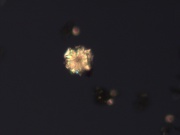Ginkgo biloba (leaf)
From AHPA Botanical Identity References Compendium
(Difference between revisions)
| Line 1: | Line 1: | ||
| − | + | ||
| − | + | ||
| − | + | ||
{{Botanical | source=AHPA Known Adulterants | {{Botanical | source=AHPA Known Adulterants | ||
| Line 15: | Line 13: | ||
| characteristics=epidermis has irregularly sinuous walls, often with palisade parenchmya, stomata deeply sunken surrounded by 6-8 subsidiary cells, various sizes of calcium oxalate cluster crystals abundant| }} | | characteristics=epidermis has irregularly sinuous walls, often with palisade parenchmya, stomata deeply sunken surrounded by 6-8 subsidiary cells, various sizes of calcium oxalate cluster crystals abundant| }} | ||
| − | |||
| − | |||
| − | |||
| − | |||
Revision as of 16:33, 23 February 2012
Ginkgo (leaf extract) (Ginkgo biloba) standardized to flavonol glycosides and terpenes.
General Characteristics AHPA recommends in its Known Adulterants list that appropriate steps be taken to assure that this raw material is free of the noted adulterant. Contact AHPA for additional information regarding relevant analytical methods or follow this link for more information.
Reported Adulterants Ginkgo (Ginkgo biloba) leaf extract with added flavonol glycosides or aglycones (e.g., rutin, quercetin, etc.).
Source: AHPA Known Adulterants [1]
|
Cite error: <ref> tags exist, but no <references/> tag was found
